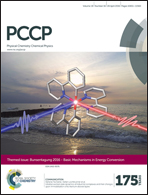The role of the internal molecular free volume in defining organic porous copolymer properties: tunable porosity and highly selective CO2 adsorption†
Abstract
A series of novel azo-functionalized copolymerized networks (simply known as NOP-34 series) with tunable permanent microporosity and highly selective carbon dioxide capture are disclosed. The synthesis was accomplished by Zn-induced reductive cross-coupling copolymerization of two nitrobenzene-like building blocks with different ‘internal molecular free volumes’ (IMFVs), i.e., 2,7,14-trinitrotriptycene and 2,2′,7,7′-tetranitro-9,9′-spirobifluorene, with different molar ratios. Increasing the content of spirobifluorene (SBF) segments with a smaller IMFV relative to that of triptycene leads to an unconventional rise–fall pattern in porosity. Unlike most reported porous copolymers whose surface area lies between the corresponding homopolymers, the copolymer NOP-34@7030 with 30% SBF segments unprecedentedly shows the largest Brunauer–Emmett–Teller specific surface area (up to 823 m2 g−1) as well as promoted CO2 uptake abilities (from 2.31 to 3.22 mmol g−1, at 273 K/1.0 bar). The 100% triptycene(TPC)-derived homopolymer (NOP-34@1000) with a moderate surface area shows the highest CO2/N2 IAST selectivity of 109 (273 K) among the five samples, surpassing most known nanoporous organic polymers. This may contribute significantly to our understanding of the relationship of IMFVs with the properties of copolymerized materials.


 Please wait while we load your content...
Please wait while we load your content...